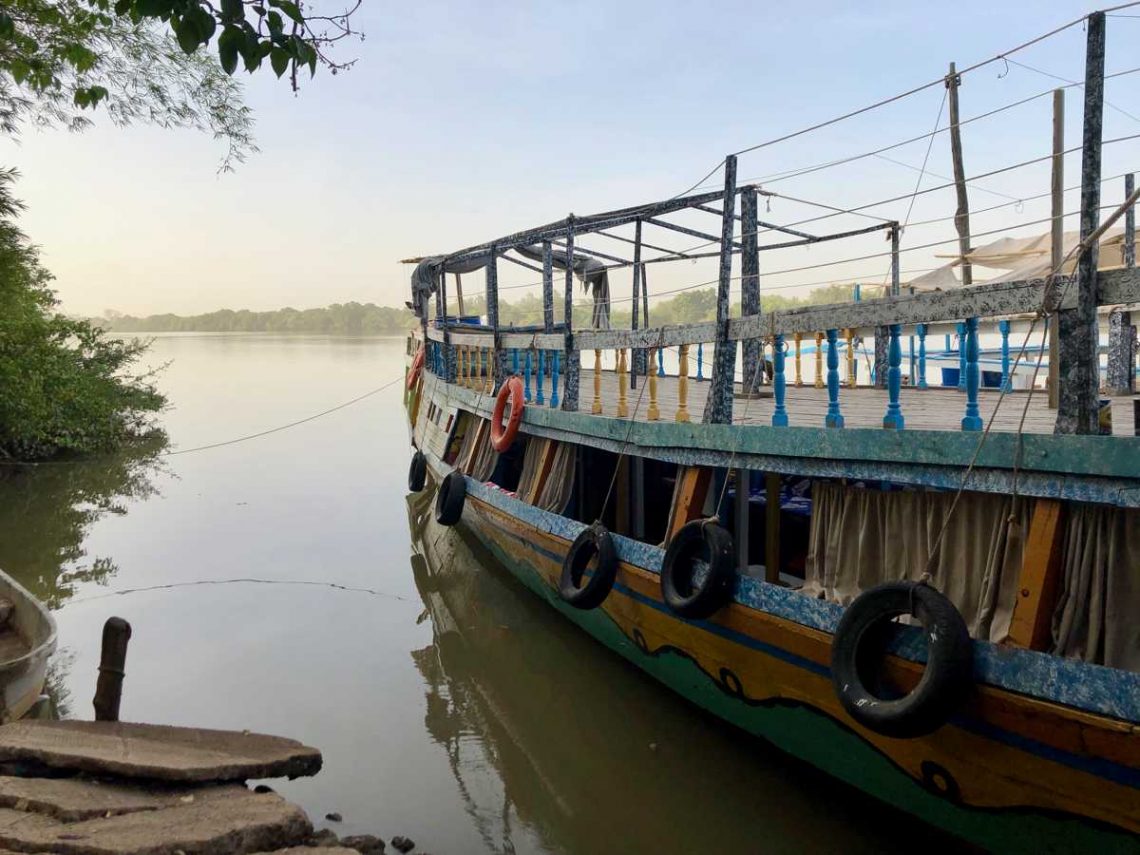
Taking a River Gambia tour: the ultimate Gambian experience
Thinking of visiting The Gambia? Check out our sister site, Travel The Gambia, for things to do, practical information and more!
I’m on a converted peanut boat in the middle of the Gambia river, exploring the less-visited side of this beautiful West African nation.
Crossing over the border with Senegal yesterday at Farafenni, we entered one of the most stable countries in Africa but also one where poverty and the aftermath of the previous government’s corruption are very apparent. Our Gambia experience began at the border town – a whirl of people and colour, where busy streets are lined with locals selling everything from vegetables to ironmongery, and where horses and carts are as much in evidence as battered cars and trucks. This is not a rich country, and the buildings and people are a study in making the most of what you have. Children run up asking for money – they are quickly rebuffed as this is not the way to support them best – but local people also smile and say hello. After French-speaking Senegal, it’s surprisingly strange to hear English being spoken again, the language of education here after British colonial rule. Around us, though, are local languages such as Wolof, Fula and Mandinka, which we have been hearing throughout this part of the world.

We are heading to the river for a two-day Gambia River cruise west from Georgetown to Tendaba. A few hours’ drive eastwards along good roads, we arrive at our home for the night, a camp of thatched huts at Camp Jang Bureh just across the river from Georgetown, from where we will board our boat the next morning. Our rooms are rondavels, the typical African circular huts which can be seen in every village and family compound along the roadside. Inside are huge double beds with mosquito nets, as well as private bathrooms with shower, but here the comfort ends. The camp has no electricity, so it’s candles and head torches as we settle in and enjoy a simple buffet dinner. The heat of the day is still in the air, but the outdoor breeze makes things comfortable as we eat and enjoy a dance performance from local village women. The ladies compete to dance as extravagantly as they can, genuinely laughing and enjoying the gentle competition between them. And of course I join in when they invite me, stamping and kicking up the dust to the rhythm of the drums.
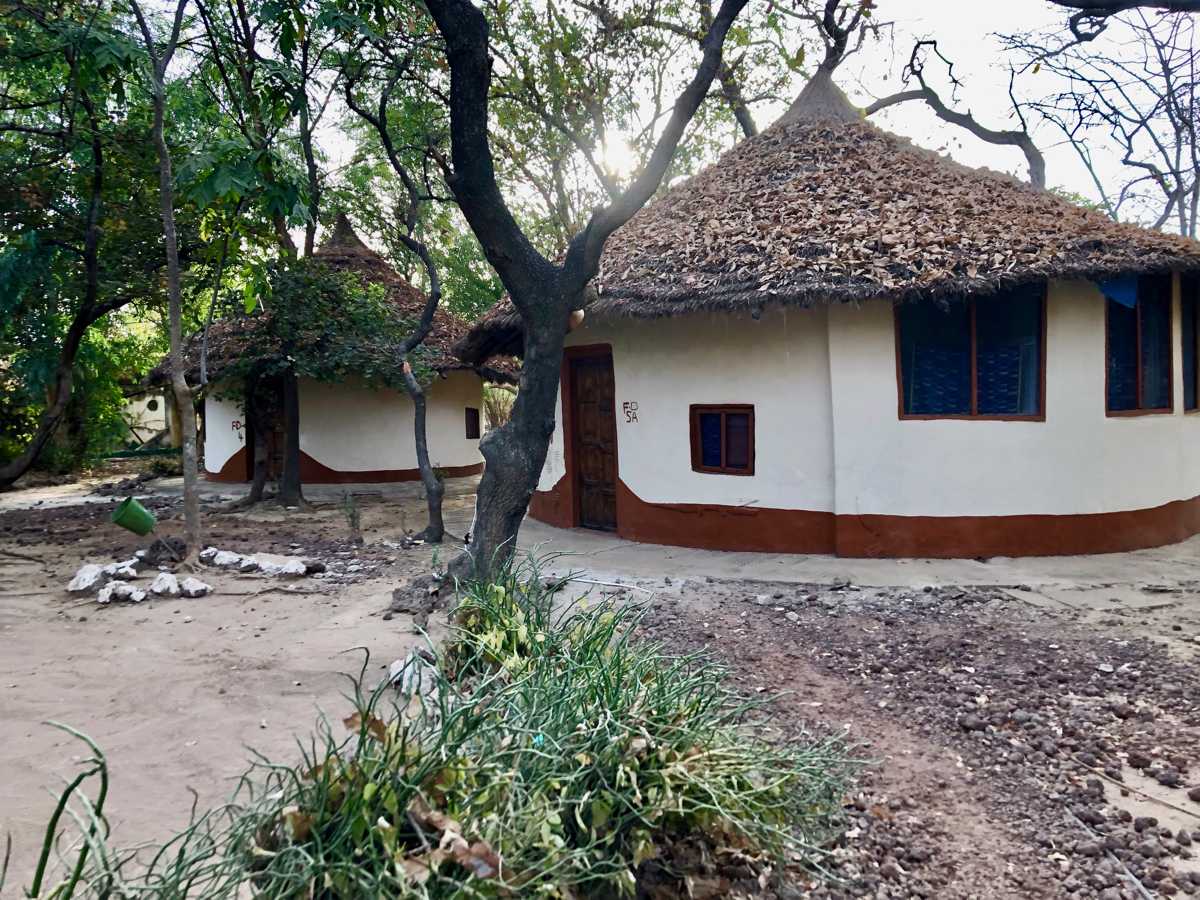
Inside the huts, the heat is still stifling as I head to bed, but a solar powered fan is running as I drop off to sleep inside my mosquito net, and doesn’t peter out until I’m safely in the land of vivid, Malarone-induced dreams. The temperature drops considerably overnight, and although I’m never cold, it’s a surprisingly good night’s sleep inside my hut, on my comfortable mattress and with fresh air flowing through the steel mesh windows. The camp is full of monkeys, and it is their chatter plus the local birdlife which wake me ahead of my alarm the next morning, ready and excited to start our river adventure.
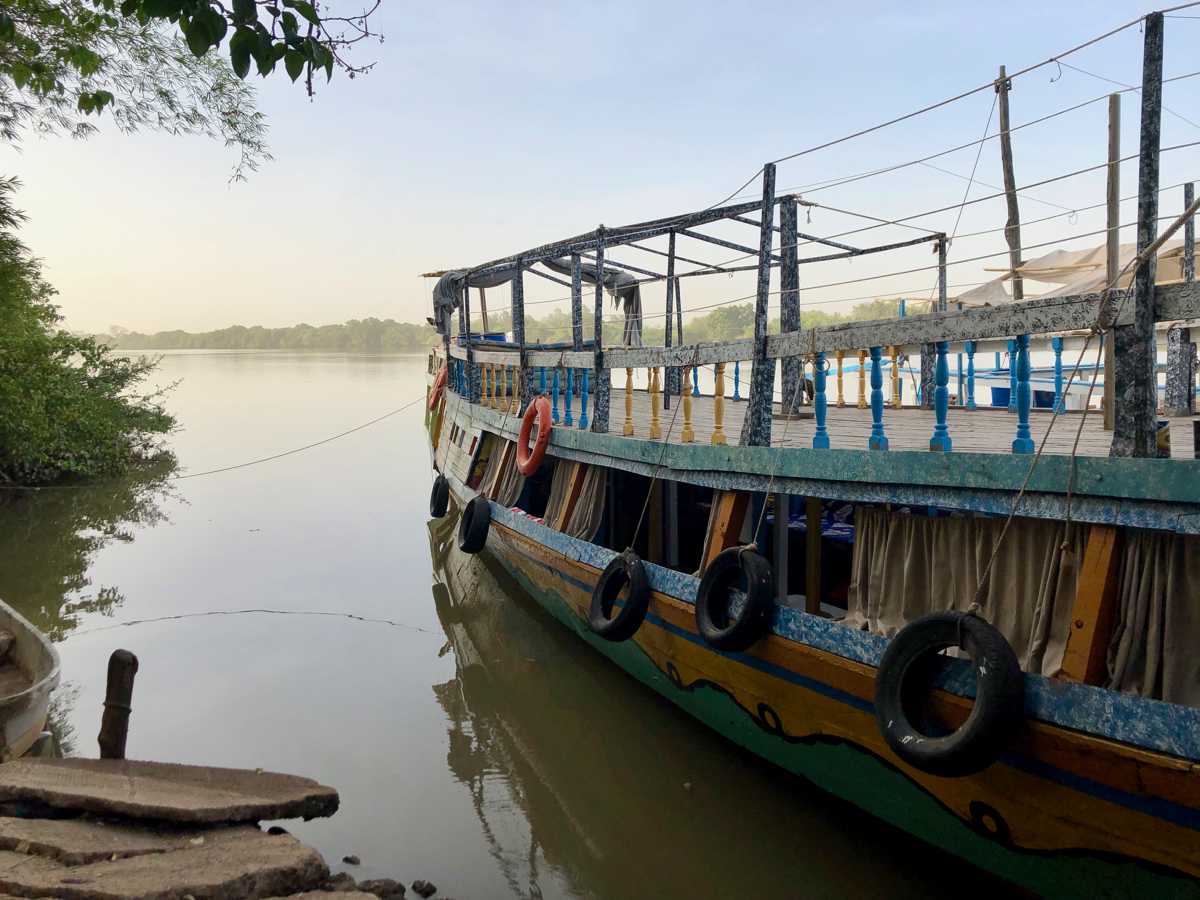
The River Gambia is the lifeblood of this small nation; it dictates the shape of the country, whose borders closely follow the river for most of its length. It even appears on the Gambian flag, with its red sun, blue river and green fertility evident in the colours of its stripes. Our boat is of traditional construction, wooden and beautifully painted in the manner of every boat I have seen in West Africa. It holds 24 passengers comfortably, so our group of 12 has plenty of room to spread out. Downstairs is a wide lower deck with cushioned benches along each side; open to the elements, there is a gentle breeze which cuts across and keeps things cool in the shade. Upstairs, the deck is open to the sunshine, although a tarpaulin will be pulled across later. This is also our bedroom for the night, and mattresses lie stacked up ready for night to fall.
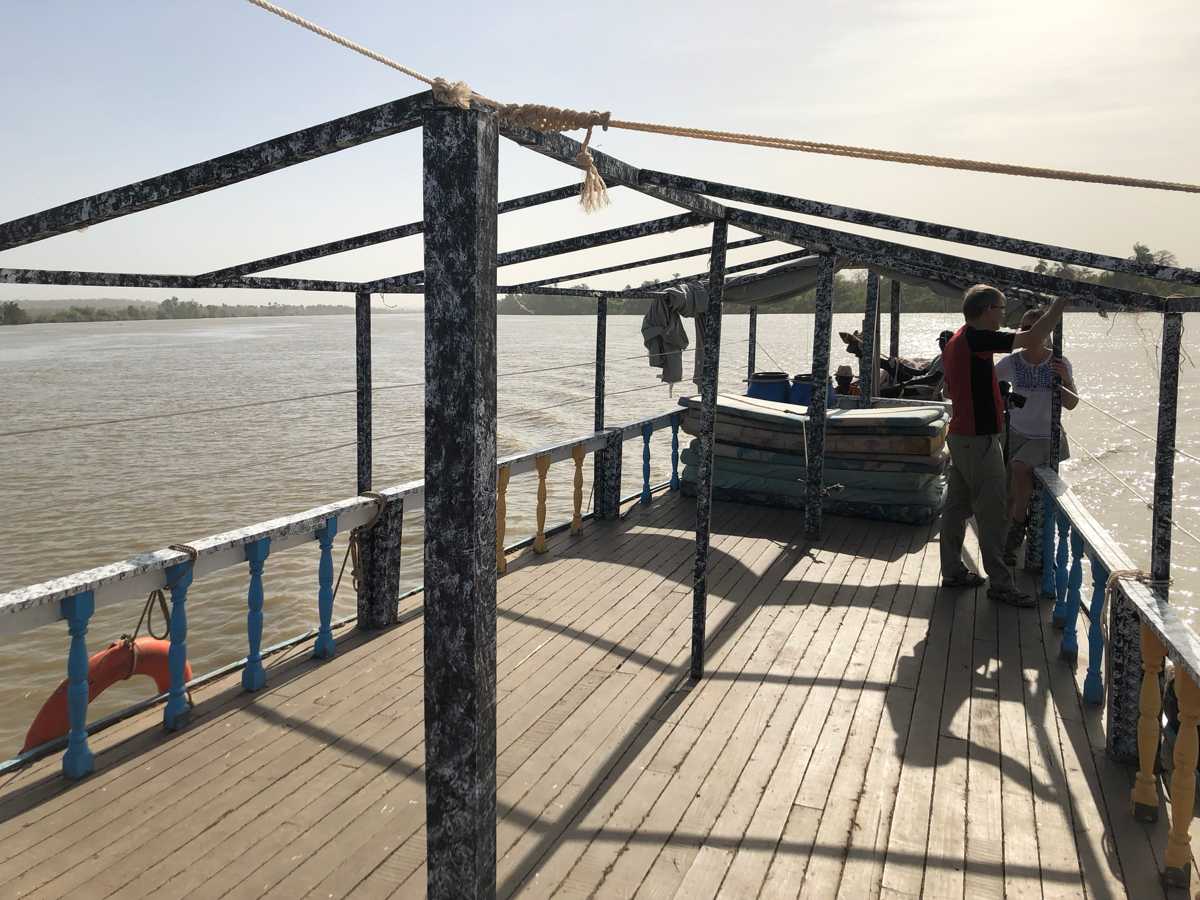
The top deck is also the best spot for viewing the river and the wildlife along its banks. The Gambia River, even this far inland, is wide and brown with silt, and lined with lush palm trees and thick vegetation. Gambia wildlife is mainly of the feathered variety: fish eagles, vultures, herons, pelicans and many other birds perch on the banks and in the trees, and fly across the skies above us. Red colobus monkeys leap through the trees along the water’s edge, and it’s even possible to spot hippos basking in the waters of the river. As we cruise, there is a serenity to this vast waterway where, apart from a few local canoes, we are the only boat we can see. We have the river to ourselves, and the peace is blissful.
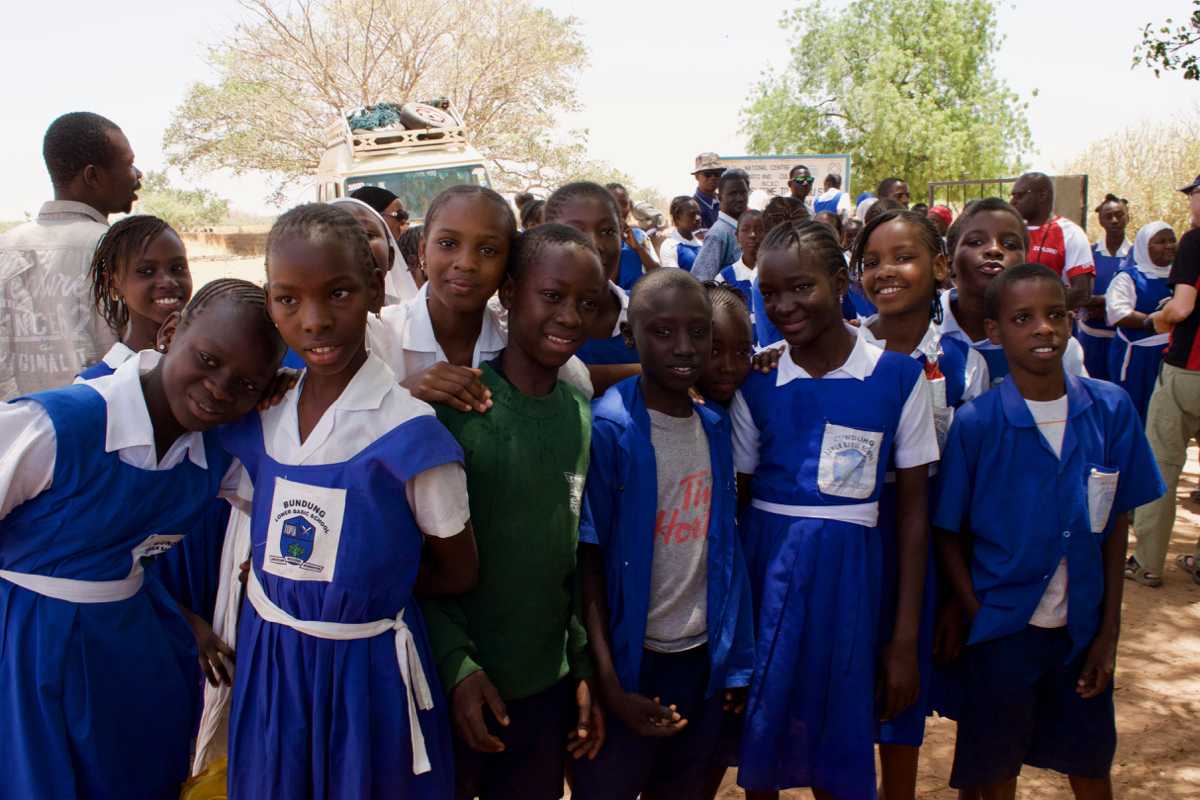
Late morning, we stop at a jetty close to the town of Wassu. The Wassu Stones, constructed around 1200 years ago, are stone megaliths believed to be an ancient burial ground. To get there from the boat, we take a bush taxi, a local minibus of ancient and dilapidated construction. The windscreen, which seems to be more cracks than glass, is held together on the passenger side by a large and faded political sticker. We pile in and set off on the 10 minute drive to the Stones, past local village houses and their inhabitants going about their business in the midday sun. Rice paddies line the sides of the road, this being the only part of the Gambia where rice is grown due to the river turning to salt water further west. A group of vultures crowds round the recently-deceased body of a donkey; when we return, half the corpse will already be gone.
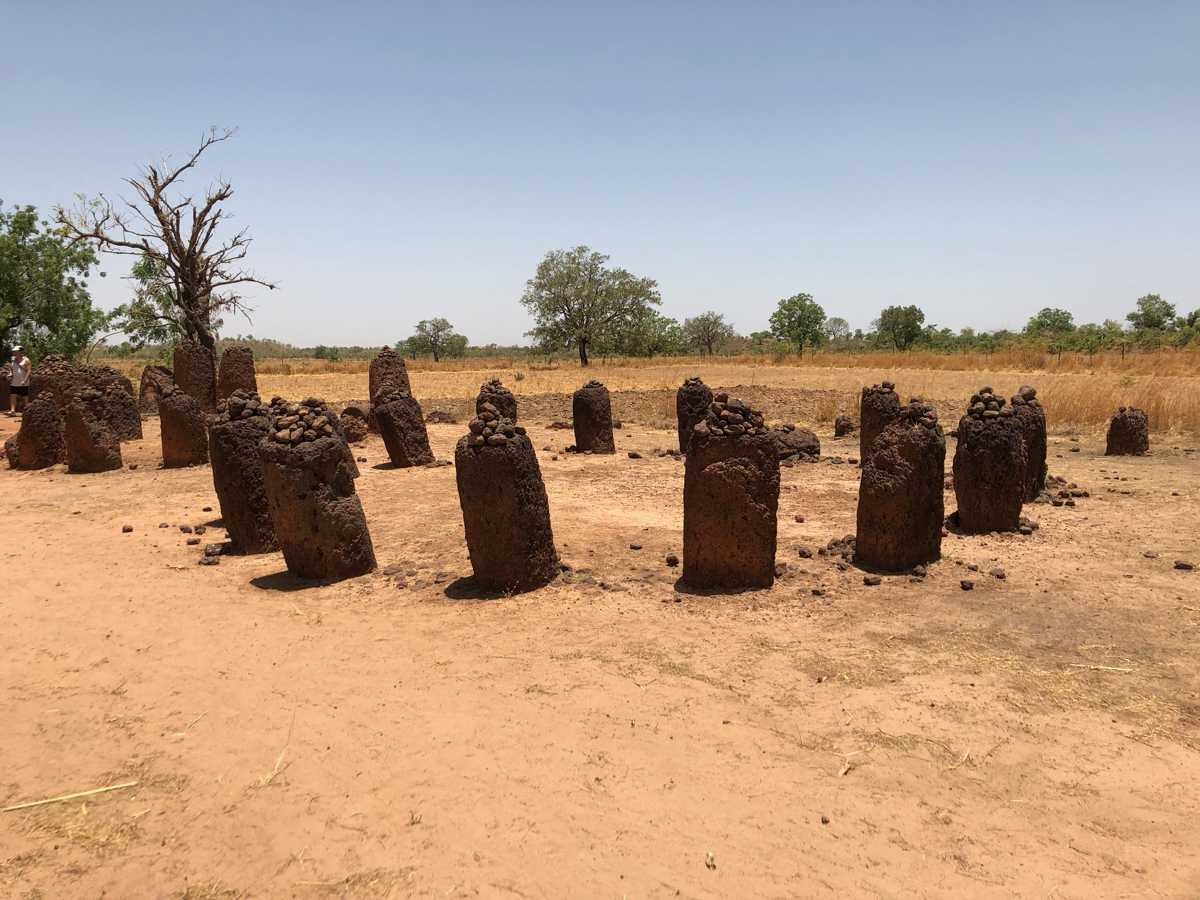
The stone circles of the Wassu Stones are a UNESCO World Heritage site. Dating from around 800-1200 AD, their purpose isn’t known for sure, but they are likely to be burial sites, the cylindrical megaliths hewn from rock a few miles away. We meet Stone Man, an eccentric character who shows tourists around. We learn very little from his explanation, which seems to focus heavily and inexplicably on the significance of the number 7, but it is high in entertainment value. A small museum provides a more scientific explanation.
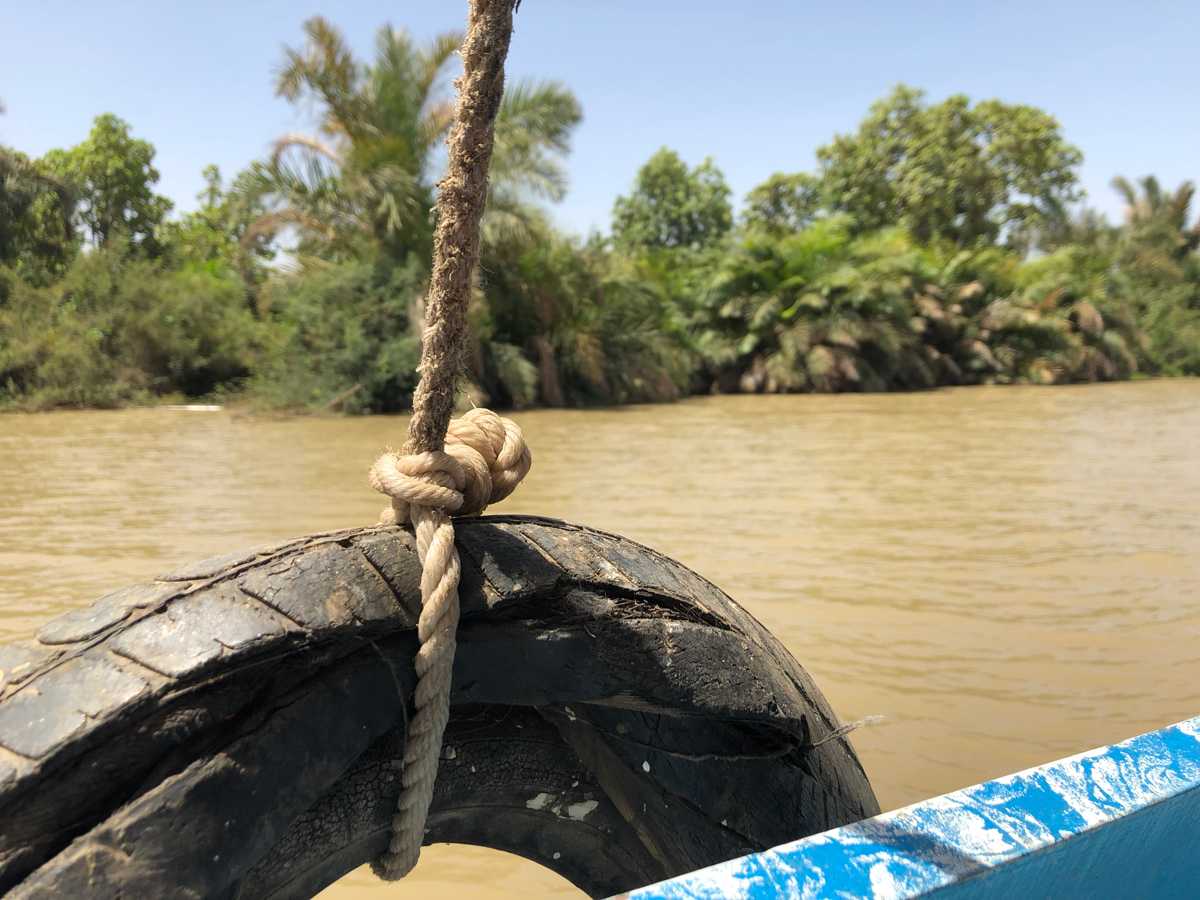
Back on the boat, our on-board cook, Jammeh, has been busy preparing a lunch of butter fish curry and rice, which is so delicious most people head back for refills. Gambia food is full of flavour, with fish and peanuts both much in evidence, to my delight. After lunch, we settle down for a slow and lazy afternoon, watching the river pass by as we cruise downstream. The banks of the Gambia are still lush with many varieties of trees; we search in vain for hippos, but we only encounter fishermen, spreading their nets widthways across the river to the exasperation of our crew, who have to ask them to move them so we can pass.

Late in the afternoon we arrive at one of the many peanut factories which lie along the river. Peanuts, or groundnuts as they are known locally, are the Gambia’s biggest export, and are much in evidence throughout the country (one of the Gambia’s most popular local dishes consists of chicken, fish or vegetables in a thick peanut sauce). Peanuts are grown in the wet season which runs from July to September, and are harvested from December onwards each year. Our visit in April coincides with the end of the season, and when we arrive at the factory it is not in operation; vast warehouses are full of peanuts waiting for the barges which will transport them downriver to Banjul for processing. Ancient equipment stands idle, while a huge mountain of peanuts sits on the dockside, presumably an overflow from the warehouse. We can only imagine what the store looks like inside.

Since a factory visit is off the table, we walk instead to the local village of Kaur, along sandy footpaths which run past paddy fields. The village is poor, with ramshackle buildings, dusty children and the ever-present chickens and goats, but the smiles of local people are friendly, and our guide tells us that, by and large, tourists are genuinely welcomed in the Gambia, with citizens appreciating the revenue that tourism brings to the country. As we walk, we learn a little more about local life and the politics of the Gambia over the last few decades, which saw a corrupt dictatorship drain the country of millions of dollars which were desperately needed by the population. Looking around us at the way of life out here in the country, the intense poverty of Kaur, it’s not hard to feel angry. And there are plenty of villages poorer than this one.
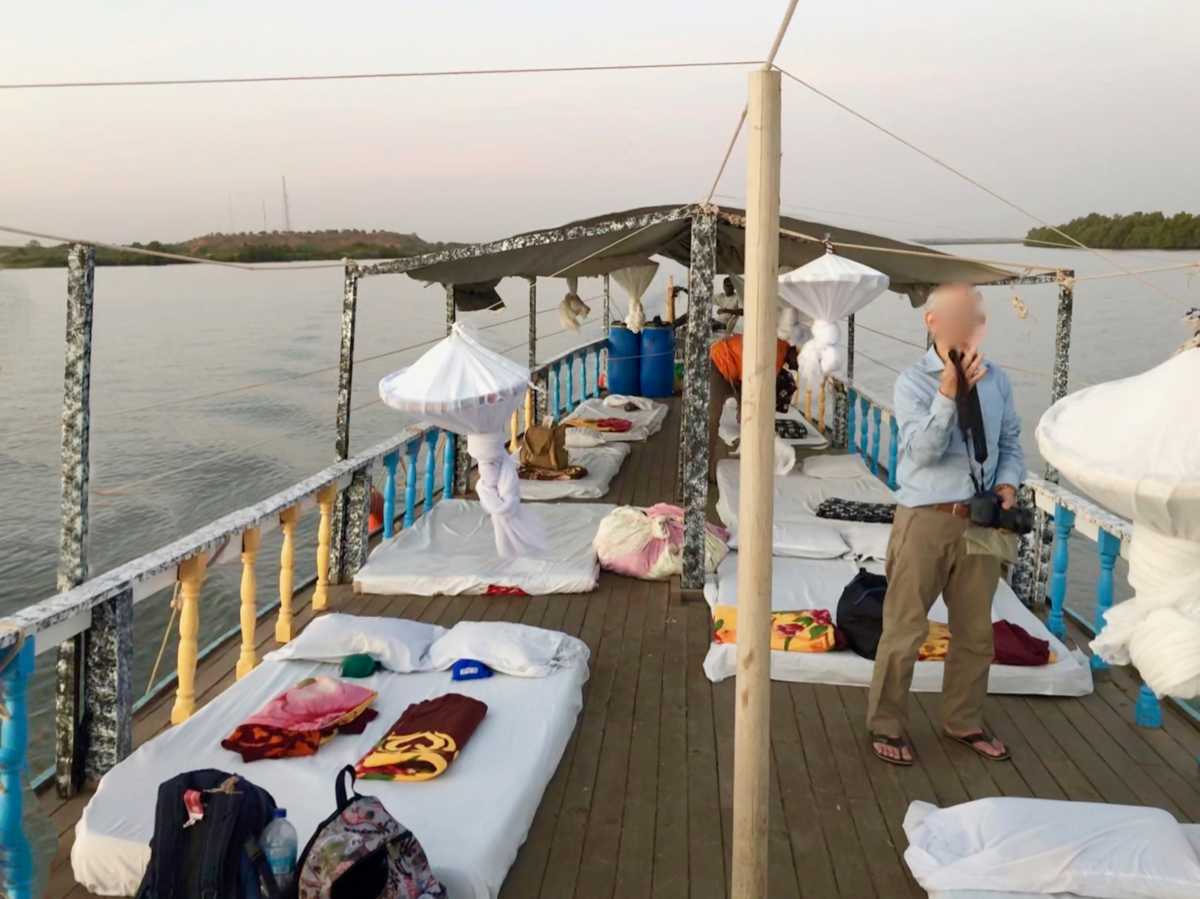
Back on the boat, it’s time for another delicious local dinner before hitting the hay – or in our case, the mattresses which have been spread out on the top deck in our absence. Each has a pillow, blanket and sheet and, best of all, an individual mosquito net, essential in this part of the world where not only malaria but Zika are still huge problems. We drop anchor and settle down for a night which starts off warm, but the temperature drops off around midnight and we are grateful for the blankets. Since it is around 40C during the daytime, this is one of the hottest times of year; although the Gambia weather never really gets cold, apparently 3 blankets are often needed in the cooler months.
The night sky above us is full of stars and, as the night progresses and we are lulled by the rocking of the boat, the Milky Way is visible in the unpolluted heavens. And the peace of the river is total.
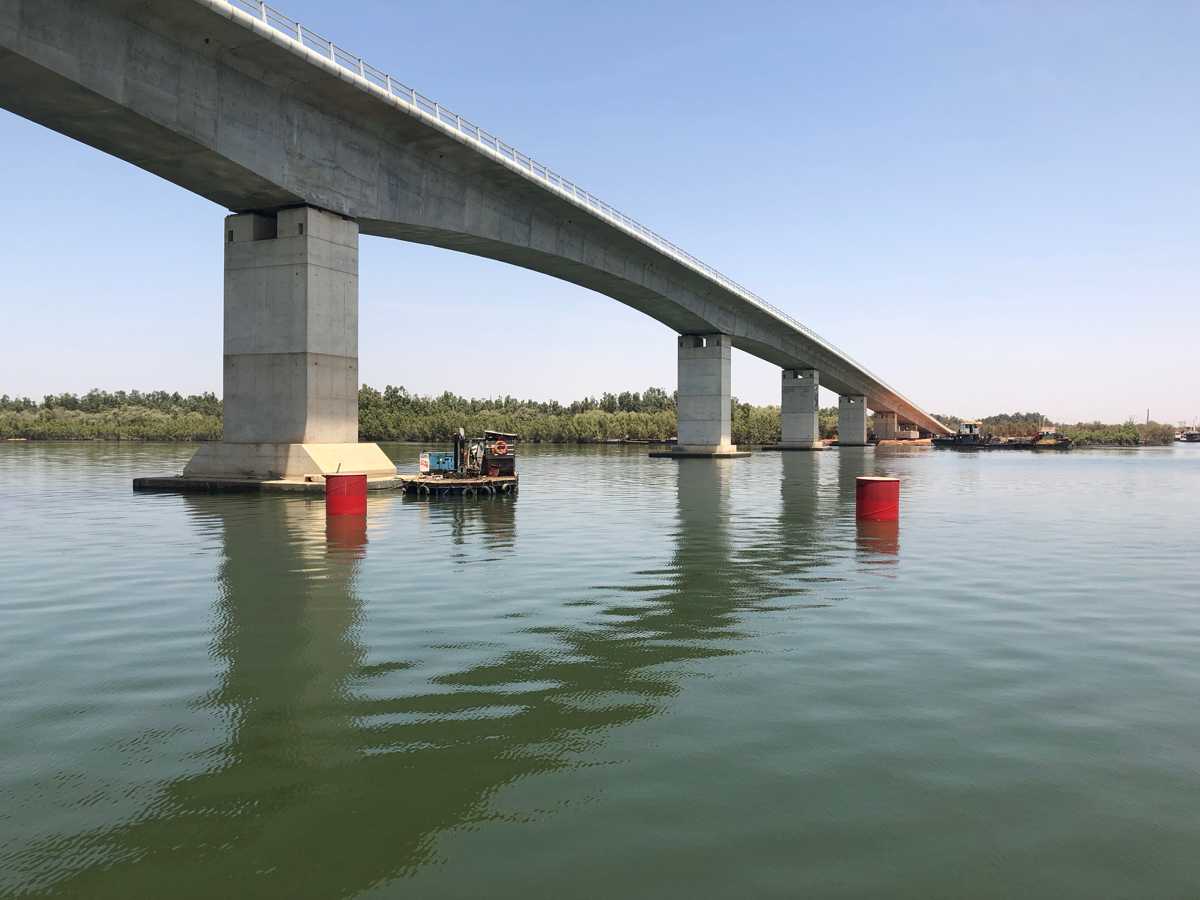
Next day we set sail westwards again, continuing our course downriver to the town of Tendaba on the Gambia’s southern bank. We pass under the Senegambia bridge between Bereto north of the river and Jenoi to the south, the only bridge across this massive waterway. The bridge, completed just 3 months ago, will ultimately help ease congestion on the single ferry which still plies its way across the river and back, carrying locals who have waited in line for up to several hours, such is the demand. The bridge is high, shiny and new. Currently there is very little traffic on it.
One final lunch and we are arriving in Tendaba, our hot and dusty home for the next two nights. Children gather on the jetty to welcome us, with very little of the begging we have seen so far and many welcoming smiles. Turning our back on the Gambia River for one last time, it has truly been a trip that dreams are made of.
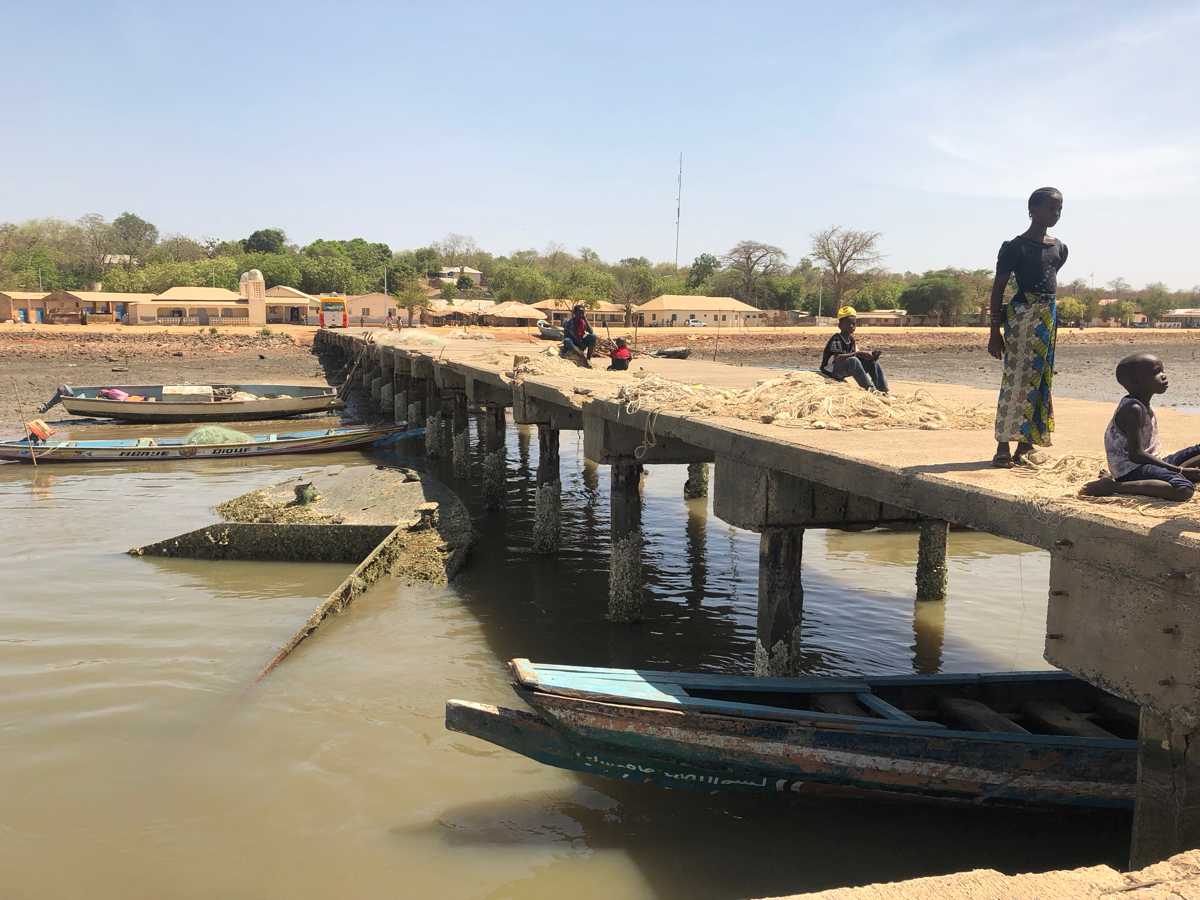
My journey
My Gambia travel was on a group trip organised by Explore! but operated locally by Gambia Tours, who can accommodate any Gambia excursions that take your fancy. Our 2-day boat trip was run by the Gambia River Excursion Company, who organise Gambia river cruises of anything between 1 day and 1 week, with popular starting points in Banjul on the coast or Georgetown in the heart of the country. Boats are simple but have western-style toilets, mosquito nets and include all meals, with drinks available for purchase. For details and to book directly, contact gambiariver@yahoo.com.
I paid for this trip personally, and this post is not sponsored in any way. All opinions are solely my own.

Visiting Africa? Check out these other posts!
- Destination Africa: The best African countries to visit
- An African market day: The local market at Camp Robin, Madagascar
- 9 Amazing animal experiences from around the world!
- Kibera slum tour: Real life in an African slum
- Traditional dances of the world: Discover local dance and folk dance
- Animal encounters: Hyenas in the night
- Anakao, Madagascar: Zebu carts, speedboats, and paradise
- The lion that climbed the tree: Life on the plains of Kenya
- Camping in Namibia: Quirky campsites and preconceptions


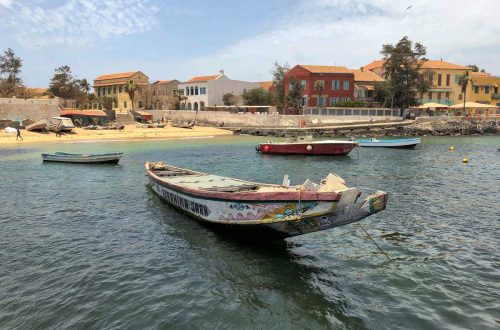
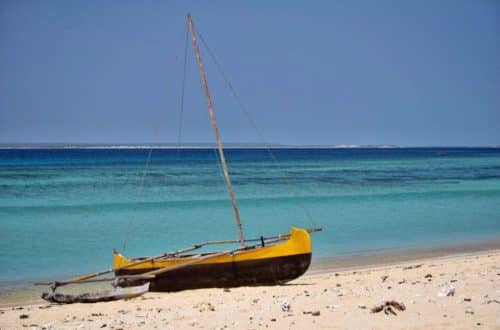
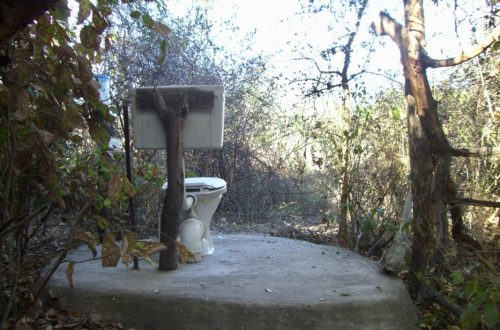
3 Comments
sam topping
Very lovely, informative post 😀 I have only been to East Africa so interesting to read this. I know you were with a tour group but in terms on safety was this a big issues at all?
Jill Bowdery
Thanks so much, Sam! Honestly no, safety wasn’t something I thought about at all in the Gambia. People are friendly and curious but not at all threatening, even with the huge disparity in wealth. I’d just use the same common sense I would use anywhere.
Val
Fantastic trip! I have been dreaming of visiting Gambia since I heard the Gambia song by Sona Jobarteh few years back so your post is what I was looking for! If you have any other advice/ tips please share 🙂